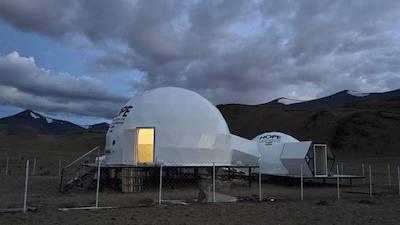
ISRO sets up station in Ladakh to simulate life on Moon & Mars
In a significant initiative to prepare for future lunar and Martian missions, the Indian Space Research Organisation (ISRO) has set up a unique station in Ladakh’s Tso Kar Valley, known as the Himalayan Outpost for Planetary Exploration (HOPE). This state-of-the-art facility will test life-support systems for long-duration space missions, mimicking the harsh conditions experienced on the Moon and Mars.
The HOPE station is a significant milestone in India’s space exploration journey, marking the first time that a space agency has set up a facility in the Himalayas to simulate life on other planets. The station will be operational for a period of 10 days, from August 1 to 10, with two crew members undertaking various tests and experiments during this period.
The Tso Kar Valley was chosen for the HOPE station due to its unique environment, which closely resembles the conditions found on Mars. The valley is characterized by high UV radiation, low atmospheric pressure, extreme cold, and saline permafrost, making it an ideal location to test the durability and functionality of life-support systems designed for space missions.
The HOPE station is equipped with advanced technology and equipment to simulate the lunar and Martian environments. The facility is designed to mimic the conditions on the Moon and Mars, including extreme temperatures, low air pressure, and UV radiation. The station will also simulate the lack of gravity, which is a critical factor in space missions.
The life-support systems being tested at the HOPE station include air, water, and food supplies, as well as waste management and recycling systems. The crew members will also conduct experiments to test the psychological and physiological effects of long-duration space travel on the human body.
The HOPE station is a crucial step towards India’s plans to send humans to the Moon and Mars in the near future. The experience gained from this mission will be invaluable in preparing for future long-duration space missions, including the ambitious Gaganyaan project, which aims to send humans to space by 2022.
The Gaganyaan project is a significant milestone in India’s space exploration journey, marking the country’s first-ever human spaceflight mission. The project aims to send three astronauts to space for a duration of five to seven days, with the ultimate goal of establishing a permanent human settlement on the Moon.
The HOPE station is also expected to play a critical role in the development of India’s future lunar and Martian missions. The experience gained from this mission will be used to develop advanced life-support systems and technologies that can withstand the harsh conditions on other planets.
The HOPE station is a testament to India’s growing capabilities in space exploration and its commitment to advancing the country’s space program. The station is a significant achievement for ISRO, marking the country’s entry into the elite club of space agencies that have successfully simulated life on other planets.
In conclusion, the HOPE station in Ladakh’s Tso Kar Valley is a significant milestone in India’s space exploration journey, marking the country’s first-ever simulation of life on the Moon and Mars. The station will test life-support systems and technologies designed for long-duration space missions, laying the groundwork for India’s future lunar and Martian missions.






